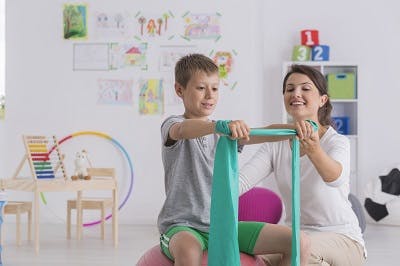No products in the cart.
No products in the cart.
No products in the cart.
No products in the cart.
Home » Neurological Recovery Blog » Cerebral Palsy » Cerebral Palsy and Posture: Early Signs, Risks, and Management
Last updated on March 19, 2021

If your loved one has cerebral palsy, it’s essential to understand how the condition may affect one’s posture.
Postural control is the ability to control the body’s position in space to obtain stability and orientation. This skill is fundamental to every movement we make. As a result, when individuals have poor postural control, a variety of other motor functions may be affected.
To help you understand the link between cerebral palsy and posture, this article will discuss:
The primary causes of compromised posture in individuals with CP are abnormal muscle tone and muscle imbalances.
Individuals with cerebral palsy may experience high or low muscle tone, or a mix of both. Having too much or too little tone may make it challenging to control movements and maintain posture.
For example, low muscle tone in the trunk may make it challenging to maintain sitting balance. Consequently, individuals with poor trunk stability may start to lean to one side.
Similarly, high muscle tone may pull the body into abnormal postures. The longer an individual remains in a specific posture, the greater their risk of developing contractures. The body becomes accustomed to consistently compromised posture, which may contribute to the development of long-term postural abnormalities.
While postural abnormalities are generally not present at birth, they typically become more prominent with age. Often, trunk deformity becomes noticeable around 7 years of age. Likewise, those with more severe motor impairments are more likely to experience postural abnormalities.
Cerebral palsy is a developmental motor disability and compromised posture significantly affects growth and development. Therefore, it’s essential to seek early intervention for postural abnormalities. Next, we’ll explain early signs of compromised posture due to CP.

Because individuals with cerebral palsy have an increased risk of developing abnormal posture, early identification and intervention are essential.
Early signs of posture problems may include:
If your child exhibits any of these signs, consult with their pediatrician. In the following section, we’ll provide education on the risks associated with compromised posture in individuals with CP.
Compromised posture due to cerebral palsy may lead to a wide range of other motor impairments.
Individuals with poorly managed posture due to CP generally have an increased risk of:
Musculoskeletal imbalances place excess strain on the bones and joints. As a result, poorly managed posture may ultimately compromise function.
In the following section, we’ll provide management interventions that may reduce the progression of posture abnormalities.

Treatment for postural abnormalities in individuals with cerebral palsy generally focuses on improving one’s functional abilities and prevent additional posture imbalance.
If not properly managed, posture may be compromised at any age. Cerebral palsy is a lifelong condition, and while the brain damage that caused it will not progress, symptoms such as abnormal muscle tone may continue to cause problems.
Some interventions to manage and improve posture include:
Depending on the severity of one’s postural abnormalities, treatment interventions vary. Ultimately, the earlier posture problems are treated, the more effective non-invasive options will be.
Cerebral palsy is a motor disability that can significantly affect one’s posture. Fortunately, there are many effective ways to prevent a decline in posture and optimize motor functions to improve your quality of life.
We hope this article helped you understand how cerebral palsy may affect posture as well as how to promote better postural control and stability.

Get our free 19-page PDF full of helpful tips for cerebral palsy by signing up below! If you liked this article, you’ll LOVE our free ebook.
When you sign up, you’ll also receive our popular emails that share more tips for life with cerebral palsy — you can opt out anytime.
We will never sell your email address, and we never spam. That we promise.


At Flint Rehab, we understand that doing physical therapy at home can become tedious and repetitive. But when repetition is critical to recovery, it’s important to stick with a repetitive regimen. But that doesn’t mean it has to be boring.
Flint Rehab is the leading manufacturer of motion-sensing, gamified rehabilitation devices. Our bestselling recovery tool, FitMi, transforms full-body rehab exercises into an interactive experience.
See what individuals with CP are saying about FitMi:
“The FitMi and MusicGlove have done wonders for my son with hemiparesis from cerebral palsy and stroke. It motivates him to do his exercises. It does not seem like therapy for him since it is fun. FitMi monitors his progress so it is a great reinforcement for him. Music is a motivator for him. He has been using it on his arm and we will try the leg exercises soon.”
-Manning
While FitMi is a recovery tool for the full-body, our other device, MusicGlove, helps target the hand to improve fine motor skills and dexterity.
See what others have said about MusicGlove:
“My granddaughter has right-side hemiplegia from Cerebral Palsy / stroke at birth. She states that this is a great product for anyone who has issues with the use of their hand(s), and that is has helped her tremendously. She also finds the music quite catchy (surprisingly!). Our occupational therapist has been impressed as well. I can say that it has arguably been the best tool of all our therapy resources.”
-Jenni
Together, FitMi and MusicGlove make a powerful home therapy regimen for individuals with cerebral palsy. Best of all, you can save money when you bundle them together.
To learn more, click the button below:

Do you have these 19 pages of helpful tips for CP?
Get a free copy of our ebook Helpful Tips for Managing Cerebral Palsy. Click here to get instant access.
Grab a free rehab exercise ebook!
Sign up to receive a free PDF ebook with recovery exercises for stroke, traumatic brain injury, or spinal cord injury below: